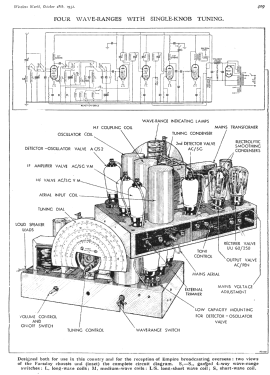All-Wave Superheterodyne S620
Faraday All-wave Wireless Company Ltd.; London
- País
- Gran Bretaña (GB)
- Fabricante / Marca
- Faraday All-wave Wireless Company Ltd.; London
- Año
- 1932 ?
- Categoría
- Radio - o Sintonizador pasado WW2
- Radiomuseum.org ID
- 360621
Haga clic en la miniatura esquemática para solicitarlo como documento gratuito.
- Numero de valvulas
- 6
- Principio principal
- Superheterodino con paso previo de RF; Anode bend detection
- Gama de ondas
- OM, OL y dos OC
- Tensión de funcionamiento
- Red: Corriente alterna (CA, Inglés = AC)
- Altavoz
- Altavoz electrodinámico (bobina de campo)
- Material
- Madera
- de Radiomuseum.org
- Modelo: All-Wave Superheterodyne S620 - Faraday All-wave Wireless
- Forma
- Sobremesa alto de forma simple.
- Anotaciones
-
The Faraday All-Wave Superheterodyne Model S620, as advertised in Wireless World on October 28, 1932, is a groundbreaking radio receiver designed to attract the British listening public, both domestically and overseas, to the intriguing possibilities of broadcasting. It combines the ability to receive both normal and short wavelengths with the simplicity and ease of operation typical of standard domestic receivers. Externally, it resembles a conventional mains-operated broadcast receiver, complete with a built-in loudspeaker. However, it includes provisions for receiving transmissions across medium and long wavebands and shortwave frequencies between 15 and 60 meters.
Technical Features
Circuit Design
The receiver incorporates a unique circuit arrangement. The high-frequency (H.F.) stage up to the intervalve coupling employs single-tuned circuits. Its frequency changer uses a tuned intervalve coupling linked by a common resistance, maintaining a frequency difference of 115 kHz through a padding condenser. On long waves, alignment is achieved with an additional trimming condenser. For short-wave bands, the H.F. stage becomes aperiodic, and adjustments are made automatically via a ganged wave range switch.The detector-oscillator connects to the intermediate frequency (I.F.) amplifier through double-tuned band-pass filters. A self-biased detector feeds the output pentode via resistance-capacity coupling. A high-note attenuator can be activated using a switch for enhanced sound quality.
Tone Correction
To address potential shrillness in gramophone record playback due to high-note loss in tuned circuits, the pentode output valve acts as an automatic tone corrector. Additionally, the volume control potentiometer functions as a variable shunt for the pick-up.Specifications
Feature Details Type Self-contained five-valve superheterodyne with moving-coil loudspeaker Operation A.C. mains with external or mains aerial; D.C. model available Wave Ranges Short (15–30 m), Long-short (30–69 m), Medium (215–550 m), Long (550–2000 m) Additional Features Gramophone pick-up provision Circuit Signal-frequency H.F. stage; combined detector-oscillator; one I.F. stage; resistance-coupled output pentode Controls Single-knob tuning, 4-position wave range switch, combined volume control/on-off switch, tone control switch Price 27 guineas; Overseas models: £30 (Walnut cabinet), £32 (Teak cabinet) Summary
The Faraday All-Wave Superheterodyne Model S620 is an innovative radio receiver combining advanced technical design with user-friendly controls. Its ability to receive multiple wavebands and its thoughtful features make it ideal for both domestic and overseas broadcasting enthusiasts.For comparison, see the later version, Model S620L (1933).
- Precio durante el primer año
- 27.00 GNS
- Mencionado en
- Wireless World (The), London (WW, 79) (Oct 28, 1932, Pages 408 & 409)
- Autor
- Modelo creado por Gary Cowans. Ver en "Modificar Ficha" los participantes posteriores.
- Otros modelos
-
Donde encontrará 3 modelos, 2 con imágenes y 3 con esquemas.
Ir al listado general de Faraday All-wave Wireless Company Ltd.; London

